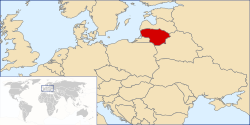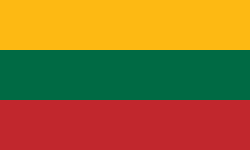
The following outline is provided as an overview of and topical guide to Lithuania:
Contents
- General reference
- Geography of Lithuania
- Environment of Lithuania
- Regions of Lithuania
- Demography of Lithuania
- Government and politics of Lithuania
- Branches of the government of Lithuania
- Foreign relations of Lithuania
- Law and order in Lithuania
- Military of Lithuania
- Local government in Lithuania
- History of Lithuania
- Culture of Lithuania
- Art in Lithuania
- Sports in Lithuania
- Economy and infrastructure of Lithuania
- Education in Lithuania
- See also
- References
- External links
Lithuania – sovereign country located in the Baltic region of Europe. [1] [2] Situated along the south-eastern shore of the Baltic Sea, sharing borders with Latvia to the north, Belarus to the southeast, Poland, and the Russian exclave of the Kaliningrad Oblast to the southwest. Lithuania is a member of NATO, OECD and the European Union. Its population is about 2.8 million. The largest city and capital is Vilnius.
During the 14th century, Lithuania was the largest country in Europe, as present-day Belarus, Ukraine, and parts of Poland and Russia were territories of the Grand Duchy of Lithuania. With the Lublin Union of 1569 Poland and Lithuania formed a new state: the Polish–Lithuanian Commonwealth, which was finally destroyed by its neighboring countries in 1795. Most of Lithuania's territory was annexed by the Russian Empire, until the Act of Independence was signed on 16 February 1918, which declared the re-establishment of a sovereign state. Between 1940 and 1945 Lithuania was occupied by both the Soviet Union and Nazi Germany at different times. When World War II was near its end in 1944 and the Nazis retreated, the Soviet Union reoccupied Lithuania. On 11 March 1990, Lithuania became the first Baltic republic to declare its restored independence after 50 years of Soviet occupation. Lithuania became a full member of the Schengen Agreement on 21 December 2007. [3] In 2009, Lithuania celebrated the millennium of its name.
The Lithuanians are a Baltic people closely related to the Latvians, with the Lithuanian language sharing many similarities to Latvian. Today the Latvians and Lithuanians are the only surviving members of the Baltic peoples and Baltic languages of the Indo-European family.






